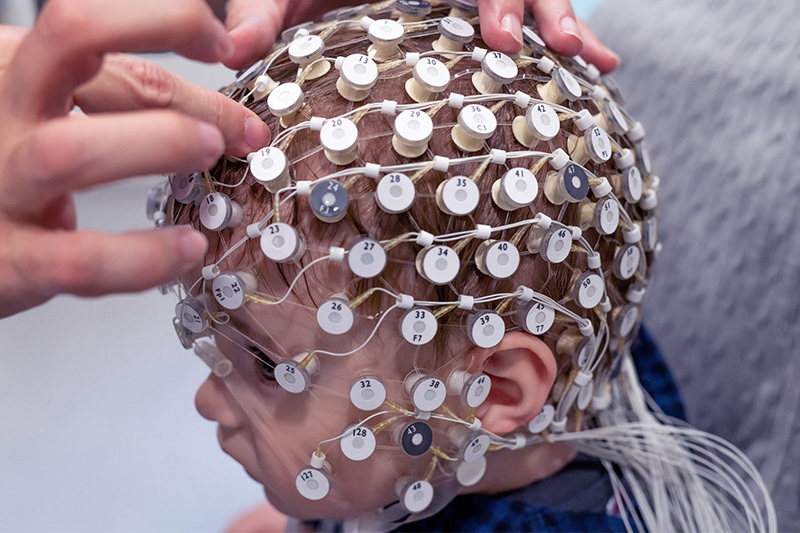EEG markers in early life could help predict and diagnose anxiety

Anxiety disorders are the most common mental health problem among children and adolescents and are a risk factor for adult disorders. Stress is a big factor — at home, at school, and from external factors like COVID-19 and climate change. But some children may be innately more susceptible to anxiety. New research at Boston Children’s Hospital suggests a possible way to detect such vulnerability before anxiety becomes apparent clinically.
In a pilot study in Frontiers in Psychiatry, Michelle Bosquet Enlow, PhD, a clinical psychologist in the department of Psychiatry and Behavioral Sciencs at Boston Children’s, and William (Bill) Bosl, PhD, in the Computational Health Informatics Program, found telltale markers of anxiety in electroencephalograms (EEGs), even in early childhood.
We hope our work eventually informs tailored interventions that take into account a given child’s specific risk profile.
Bosl is a computational scientist who focuses on clinical neurophysiology and neurodiagnostics. He has developed expertise in analyzing brain “electrodynamics” — not brain waves themselves, but signals and patterns extracted from EEGs that give insights into brain organization and functioning.
“Bill has ways to dig into the EEG data and pull out information you can’t see with the human eye,” says Bosquet Enlow. “We want to understand: Is there something we could detect in early development, before behavioral or emotional symptoms emerge, that signals a difference in neural circuitry? And if so, could such differences be targeted through preventative interventions?”
EEG signatures for anxiety?
The study included 150 children enrolled starting in infancy. At age 5 years, a semi-structured interview with the child’s mother assessed the child’s psychiatric diagnostic history. The children had EEG recordings in infancy and at ages 3, 5, and 7 years.
Bosl and Bosquet Enlow found that EEG signals at age 7 most robustly distinguished children with an anxiety disorder from healthy controls. However, there were signals even at 3 and 5 years of age. Recordings from two or three time points (excluding infancy) gave much better results than the age 7 recordings alone.
“We found that not just a snapshot, but trajectories over time are the most predictive,” says Bosquet Enlow. “A single EEG is only telling you what the brain is doing at that moment.”
“We’re not trying to make a diagnosis, but we’re computing risk assessments or probabilities for anxiety, which is more natural and appropriate,” says Bosl.
The study also looked at EEG patterns in children with externalizing disorders like ADHD or oppositional defiant disorder. Patterns were distinct from both those in children with anxiety and those in healthy controls. The conditions could be detected as early as ages 3 and 5, especially with two or three recordings rather than a single snapshot.
Future directions
Bosl and Bosquet Enlow are now following the children to age 13, since adolescence is a time of enhanced risk for anxiety. In the future, they hope to:
- Analyze EEG patterns associated with different subtypes of anxiety, such as social anxiety, generalized anxiety, phobias, and separation anxiety. These may have distinct signatures.
- Look at EEG readings taken while showing children an anxiety-provoking stimulus (this study only analyzed resting EEGs).
- Determine how to combine EEG findings with measures like behavioral data, maternal anxiety/depression, and environmental stressors to reliably predict child psychopathology risk as early in development as possible.
“We’re still figuring out what other variables to put in the model to make it even more predictive of anxiety,” says Bosquet Enlow. “I do think the environment is critical and interacts with what the child’s bringing.”
Their long-range vision is to bring EEG measurements into routine pediatric check-ups using next-generation portable EEG devices, especially in areas with limited access to mental health professionals.
As for interventions, they could vary depending on the type of anxiety and what Bosquet Enlow and Bosl find to be the most relevant factors in developing anxiety.
“We hope that our work eventually informs more tailored interventions that take into account a given child’s specific risk profile,” says Bosquet Enlow. “Treatments that are specific to a child’s biology and environment may have the greatest success in reducing or preventing symptoms.”
Learn more about Psychiatry and Behavioral Health research at Boston Children’s.
Related Posts :
-

Four ways to support your teen's mental health
Being a teen is hard enough, but with the current adolescent mental health crisis, parents should know about the psychosocial ...
-

Teens, anxiety, and depression: How worried should parents be?
Part of the work of being a teenager is making connections outside of the family and becoming attuned to world ...
-

MIS-C's long-term effects on mental and neurologic health
Children and adolescents who have had multisystem inflammatory syndrome in children (MIS-C) after exposure to COVID-19 are recommended to have ...
-

Empowering pediatricians to provide mental health care
By late adolescence, up to 20 percent of children will have experienced impairing levels of anxiety, depression, and/or ADHD, the ...





